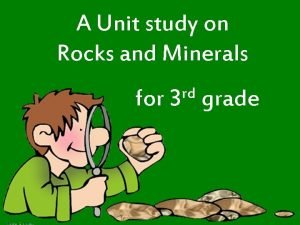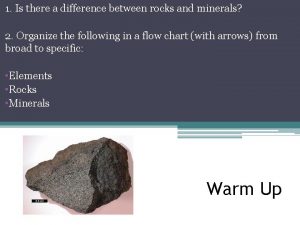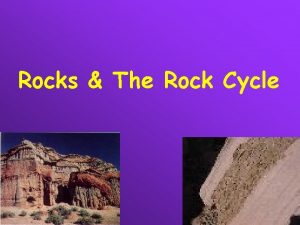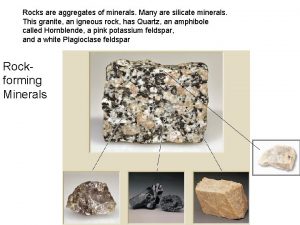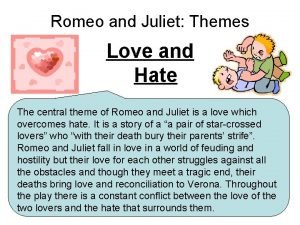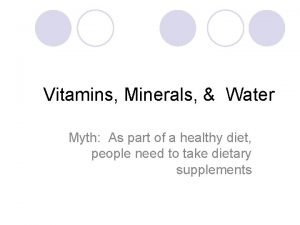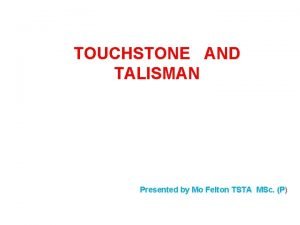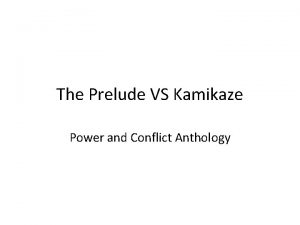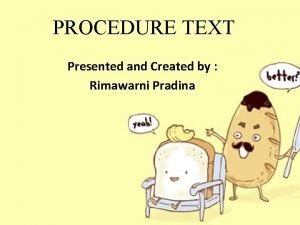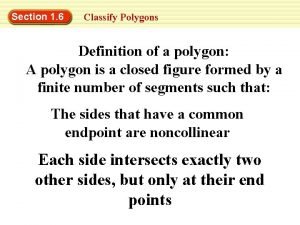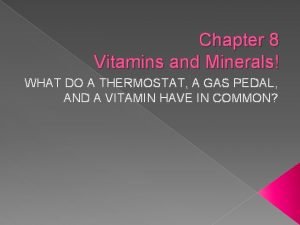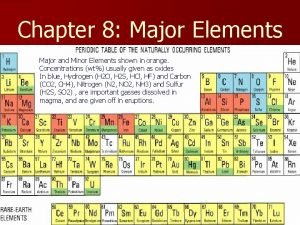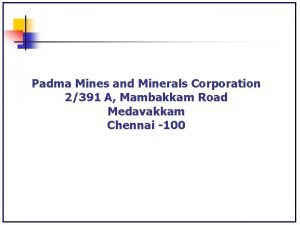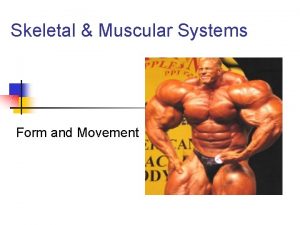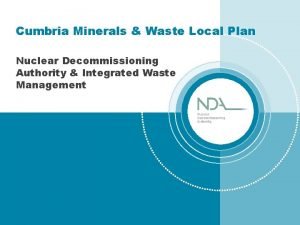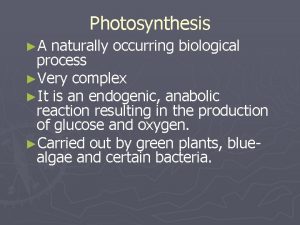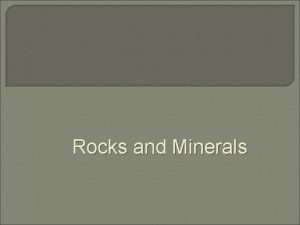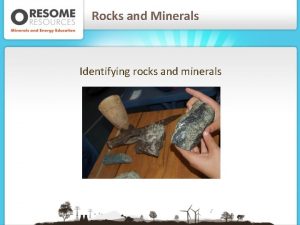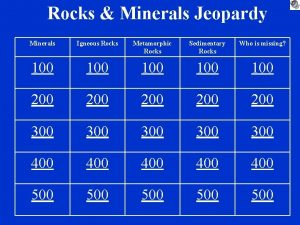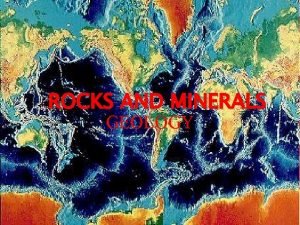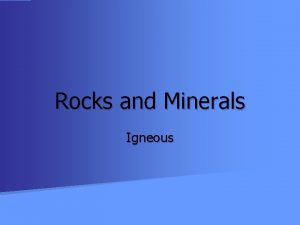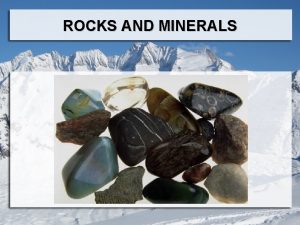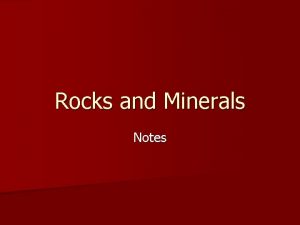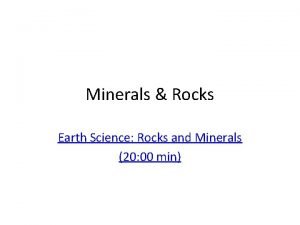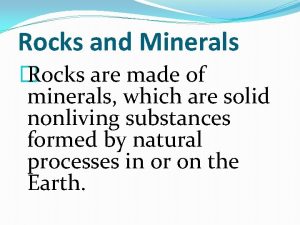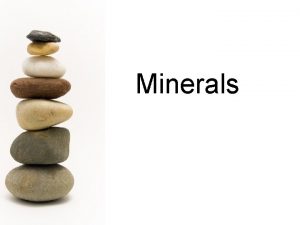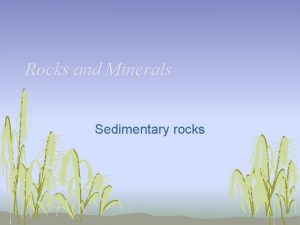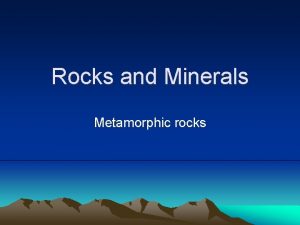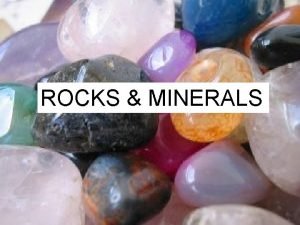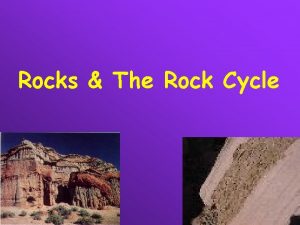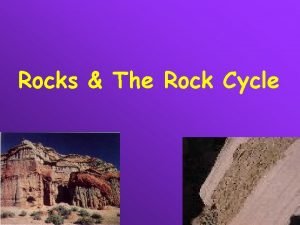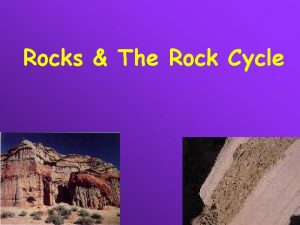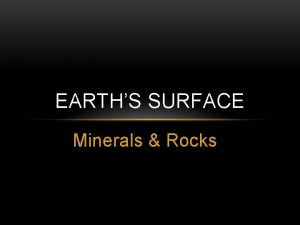Rocks and Minerals in Our Daily Lives Presented























































































- Slides: 87

Rocks and Minerals in Our Daily Lives Presented by : Jim Bastian, Hanson Material Service

Fluorite

• Fluorite is the Illinois State Mineral. Harden County is the only area in Illinois where the mineral is mined.

• Drinkingin…. water Found • • Toothpaste Steel Manufacturing Aluminum Products Chemicals

Copper

• The mineral malachite is shown along with several other copper ores – native copper, chalcopyrite and azurite. One of the largest copper mines in the world is located at Bingham Canyon in Utah.

Found in… • • Wiring Tubing Coins Brass Communications Electronics Appliances

Talc

• Talc is an important industrial mineral. Most commonly it is known as the primary ingredient in talcum powder. Its resistance to heat, electricity and acids make it an ideal surface for lab counter tops and electrical switchboards.

Found in…. n n Cosmetics Baby Powder Paint Paper

Kaolinite

• • The greatest demand for Kaolinite is in the paper industry to produce a glossy paper such as is used in most magazines. Also, used for the production of cat litter.

Found in… • • Paper Paint Fertilizer Rubber products PVC pipe Medicine Kaopectate

Galena

• Galena is a common and popular mineral for rock hounds. Its characteristic cubes, distinctive cleavage and high density make it easy to identify and a favorite in high school geology labs. The town of Galena in Northwest Illinois is named after this mineral which was extracted from the large number of lead mines developed in the area in the last century. Over 80% of all lead mined world wide is used in batteries.

Found in… • • • Batteries Fishing tackle Lead crystal Medical shields Ammunition

Zinc

• Zinc is the fourth most common metal in use, mostly as an anti-corrosion agent. Since 1982 it is the primary metal used in making American one cent coins. It is a bluish-white, lustrous, diamagnetic metal. Zinc is somewhat less dense than iron and has a hexagonal crystal structure. For a metal, zinc has a relatively low melting point and a fairly good conductor of electricity. Many alloys contain zinc, including brass (zinc and copper), aluminum, gold, iron, lead, silver, tin, and nickel among others. The element is normally found in association with other base metals such as copper and lead in ores which meant it was mined along with lead in the Galena, Illinois area.

Galvanized Found in… metal • • • metal Pipe fittings White paint pigment Vitamin supplements American one cent coins Batteries Galvanized Metal

Silica

• Silicon is rarely found in nature in its uncombined form. In fact it is amazing how rare native silicon is with 25. 7% of the Earth’s crust being silicon. Silicon, binds strongly with oxygen and is nearly always found as silicon dioxide (Quartz)

Found in… • • • Electronics Computer Industry All types of glass Nail polish Cleaners Ceramics Paint Abrasives Sand blasting

Gypsum

• Gypsum is one of the more common minerals in sedimentary environments. It is a major rock forming mineral that produces massive beds, usually from precipitation out of highly saline waters.

Found in…. • • Plasters Wall board Porcelain Pharmaceuticals Medicines Soil conditioners Bakery goods Cement

Hematite

• Hematite is an important ore of iron and it’s blood red color lends itself well in use as a pigment. Hematite gets its name from a greek word meaning blood-like because of the color of its powder.

Found in… • • • Automobiles Ships Appliances Canned goods Vitamins Pigments Nails Cooking utensils communications

Graphite

• • Graphite is a polymorph of the element carbon. Diamond is another polymorph. The two share the same chemistry, carbon, but have very different structures and very different properties. *Diamond is the hardest mineral known to man, Graphite is one of the softest. *Diamond is an excellent electrical insulator, Graphite is a good conductor of electricity. *Diamond is the ultimate abrasive, Graphite is a very good lubricant.

Found in…. • • • Pencil lead Lubricants Bricks Sports equipment (tennis rackets, skis, golf clubs, fishing rods) Aerospace

Halite

• Halite, better known as rock salt, can easily be distinguished by its taste. Since taste is an important property of salt there is a right way to taste a specimen of halite and a wrong way. The right way is to first lick your index finger, rub it against the specimen and then taste the finger.

Found in… • • Table salt Water softening Drinking water Bleach Cloth Chemicals Livestock Supplements

Dolomite

• Dolomite, which is named for the French mineralogist Deodat de Dolomieu, is a common sedimentary rock-forming mineral that can be found in massive beds several hundred feet thick. They are found all over the world and are quite common in sedimentary rock sequences. These rocks are called appropiately enough dolomitic limestone.

• Crushed stone for concrete Asphalt paving Roofing shingles Carpet backing Chemicals Medicines Cosmetics Plaster Stucco Found in… • •

n Before wallboard became popular walls were made out of plaster. Plaster is made from pressure hydrated dolomitic lime. Crown Lime was one of the leading brands and it was made from the chemically pure dolomite from Thornton Quarry near Chicago.

Did you know? ? • If the makers of the ship, Titanic, had used more lime in the steel making process, the steel would have been more malleable and stronger. The titanic could have beaten the battle with the iceberg. Instead, brittle steel was made and the rest is history.

Garnet

• One of the not-so-common minerals that many of us rely on everyday that is if we wear glasses – the chances are good that lenses may have been polished and ground to the prescribed thickness by a fine garnet compound. Sandpaper and many other abrasives as well as beautiful gemstones and jewelry are made from garnets.

Found in… • • • Fine polishing and grinding Sandpaper Abrasives Gemstones Jewelry

Magnetite

• Magnetite is a natural magnet, hence the name, giving it a very distinguishing characteristic. Magnetite is a major ore used in the production of iron.

Found in… • Another major ore of Iron (magnetic)

Bauxite

• Bauxite is often thought of as a mineral but is really a rock composed of aluminum oxide and hydroxide minerals such as gibbsite, boehmite and diaspore

Found in…. • • • • Used in beverage cans Deodorant Spark plugs Windows Doors Gutters Siding Autos Aerospace Bicycles Electronics Communication equipment Lighting

Pumice

• Pumice is formed from lava that is full of gas. The lava is ejected and shot through the air during an eruption. As the lava hurdles through the air it cools and the gases escape leaving the rock full of holes. Pumice is so light that it actually floats on water. Pumice is ground up and used today in soaps, abrasive cleansers, and also in polishes.

Found in… • Abrasive in Lava soap

Coal

• Organic sedimentary rocks form from the build up and decay of plant and animal material. This usually forms in swamp regions in which there is an abundant supply of growing vegetation and low amounts of oxygen. The vegetation builds so quickly that new layers of vegetation bury the dead and decaying material very quickly. The bacteria that decay the vegetation need oxygen to survive. Because these decaying layers are buried so fast the bacteria use up what oxygen there is available and can not finish the decomposition of the vegetation. The overlaying layers become so heavy that they squeeze out the water and other compounds that aid in decay.

• • This compressed vegetation forms coal. The longer and deeper that coal is buried makes it of higher quality. Peat is the first stage of coal formation. Lignite is the next grade of coal followed by bituminous and the highest grade, anthracite. Anthracite is actually a metamorphic rock. It forms during mountain building when compaction and friction are extremely high. This form of coal burns very hot and almost smokeless. It is used in the production of high grade steel.

Found in… • Energy production

End Of Section

Some Environmental uses of Minerals

Barite n Hazardous wastes – weighting agent in oil well drilling mud to keep oil in the drill hole (prevents “gushers” which would contaminate soil on the surface around the oil well)

Clays n n n Air quality – replacement for asbestos in many construction and industrial applications Hazardous waste disposal – solidification of organic wastes and salt solutions containment of hazardous wastes by encasement or by impermeable barrier Water treatment – selective absorbance of organic contaminants from waste water removal of pain residue from water in industrial processes

Diatomite Horticulture - non chemical insecticide n Water Treatment – purification of water by removing impurities down to 0. 1 micron without the use of filtration chemicals (uses from water treatment plants to swimming pools) n

Gold n Energy conservation – micro coating on glass reflects solar energy, reducing air conditioning electrical demand

Halite (salt) n Water treatment - provides the chlorine used as a disinfectant

Limestone n n n Agriculture – soil stabilization and p. H control Air quality – neutralizes sulfur oxides from industrial stock gases Hazardous Waste Disposal – stabilizes sludge from sewage and desulfurization plants Water treatment – removes phosphorus and nitrogen, odor control, kills bacteria; aids in clarification Water treatment – potable water softening and clarification; aid-rain and acid drainage neutralization

Lithium n Energy conservation - high density, high energy batteries for numerous applications including propulsion of electric cars

Perlite Horticulture – soil conditioning and water retention n Water treatment – filtration of water in food processing, industrial applications, and swimming pools n

Platinum Hazardous waste – shows promise in treating toxic wastes n Air quality – automobile catalytic converters; petroleum-refining catalysts to control sulfur dioxide emissions n

Rare earths Air quality – automobile catalytic converters; petroleum-refining catalysts to control sulfur dioxide emissions n Energy conservation – phosphors in low energy fluorescent lightening; replaces cadmium (toxic) in certain batteries n Recycling – use in permanent magnets for separation of metals from other wastes n

Sandstone and crushed rock n Water conservation – groundcover for xeriscape (low water use) landscaping

Silver n Water treatment – kills bacteria in water purification systems

Sulfur n Energy conservation – phosphor in low energy lighting

Zeolites n n Agriculture – stabilization of ammonium and potassium in soil Air quality – air filtration, odor control, and purification of gases and air by selectively absorbing gases such as: ammonium, hydrogen sulfide, carbon monoxide, nitrogen, formaldehyde and mercaptan Hazardous waste – heavy metal and nuclear waste containment Water treatment – ammonium removal

The Quiz END

Answers

Question 1 23, 000 Every year, more than _____ pounds of new minerals must be provided for every person in the United States to make things we use, every day.

Question 2 Which of the following rocks can float in water? a. Bauxite b. Pumice c. Other ____

Question 3 Which of the following are edible? a. Fluorite b. Hematite c. Halite d. Both a and c e. All of the above

Question 4 Which of the following minerals are used in agriculture? a. Limestone b. Zeolites c. Perlite d. Both a and b e. All of the above

Question 5 Which of the following does not help clarify water? a. Clays b. Perlite c. Zeolites d. Lithium

Question 6 Which mineral is used in the paper industry to produce a glossy paper? a. Kaolinite b. Talc c. Limestone d. Both a and b e. All of the above

Question 7 Which of the following products contain gypsum? a. Porcelain b. Bakery goods c. Glass d. Both a and b e. All of the above

Question 8 Which of the following products is not made from Dolomite? a. Roof shingles b. Cosmetics c. Beverage cans d. Carpet backing

Question 9 What is the main product produced at the Bingham Canyon Mine? Copper ________

Question 10 Which mineral is rarely found in it’s native form and yet the earth’s curst contains 25. 7% of it? Silica ________

Question 11 What is the Illinois State Mineral? Flourite ________

Question 12 What is a geologist referring to when they identify a rock as an FLR? Funny ____ Looking _______ Rock ____

Can you identify this rock?

It is a type of FLR…… …because its ILLINOIS For real End K. J. G Production
 Igneous metamorphic and sedimentary
Igneous metamorphic and sedimentary Compaction and cementation
Compaction and cementation Energy in our daily lives
Energy in our daily lives Eye contact is woven into the fabric of our daily lives.
Eye contact is woven into the fabric of our daily lives. Song about igneous rocks
Song about igneous rocks Why is bowen's reaction series important
Why is bowen's reaction series important Difference between rocks and minerals
Difference between rocks and minerals Concept map of types of rocks
Concept map of types of rocks Suzanna socked me sunday poem
Suzanna socked me sunday poem Whats the difference between rocks and minerals
Whats the difference between rocks and minerals Rock type
Rock type Quartzite rock cycle
Quartzite rock cycle Rocks are aggregates of minerals
Rocks are aggregates of minerals Extrusive vs intrusive igneous rocks
Extrusive vs intrusive igneous rocks Site:slidetodoc.com
Site:slidetodoc.com The mass media play an important
The mass media play an important Drawing the power of jesus christ into our lives
Drawing the power of jesus christ into our lives 6 word memoirs about volleyball
6 word memoirs about volleyball Tissue imtiaz dharker context
Tissue imtiaz dharker context What role does nature play in our lives
What role does nature play in our lives During our lives, we produce three kinds of hair:
During our lives, we produce three kinds of hair: God's work in our lives
God's work in our lives Our healthier nation (1999)
Our healthier nation (1999) Examples of projectile motion
Examples of projectile motion Importance of information technology in daily life
Importance of information technology in daily life Real world application of polynomials
Real world application of polynomials Chapter 10 lesson 3 healthy food guidelines
Chapter 10 lesson 3 healthy food guidelines Acrostic poem for catalyst
Acrostic poem for catalyst Our awareness of ourselves and our environment
Our awareness of ourselves and our environment Our awareness of ourselves and our environment is called
Our awareness of ourselves and our environment is called Awareness of ourselves and our environment is
Awareness of ourselves and our environment is Our awareness of ourselves and our environment is called
Our awareness of ourselves and our environment is called Jekyll and hyde quotes about setting
Jekyll and hyde quotes about setting Theme of hate in romeo and juliet
Theme of hate in romeo and juliet Juxtaposition in ozymandias
Juxtaposition in ozymandias Ozymandias and london venn diagram
Ozymandias and london venn diagram Example of text structure cause and effect
Example of text structure cause and effect Thinking language and intelligence
Thinking language and intelligence Our census our future
Our census our future Ok 313
Ok 313 Our life is what our thoughts make it
Our life is what our thoughts make it We bow our hearts we bend our knees
We bow our hearts we bend our knees Our census our future
Our census our future Our life is what our thoughts make it
Our life is what our thoughts make it The poem money madness is written by
The poem money madness is written by God our father christ our brother
God our father christ our brother Our future is in our hands quotes
Our future is in our hands quotes Minerals sources functions and deficiency chart
Minerals sources functions and deficiency chart Inverted pyramid
Inverted pyramid Presenter name
Presenter name Which idea is presented in both passages
Which idea is presented in both passages Presenter name
Presenter name Cognitive learning theory was presented by
Cognitive learning theory was presented by How is mr hyde presented as a frightening outsider
How is mr hyde presented as a frightening outsider Talisman presented
Talisman presented Main idea and supporting details definition
Main idea and supporting details definition How is the power of nature presented in the prelude
How is the power of nature presented in the prelude Technological design process
Technological design process Bob cratchit quotes
Bob cratchit quotes How is the text presented
How is the text presented Introduction to conic sections
Introduction to conic sections Prism is presented with
Prism is presented with Introduction to drafting
Introduction to drafting Generic structure of spoof text
Generic structure of spoof text Proudly presented by
Proudly presented by Macbeth act 5 scene 5 analysis
Macbeth act 5 scene 5 analysis Macbeth act 1, scene 4 translation
Macbeth act 1, scene 4 translation If a plant asset is retired and is fully depreciated
If a plant asset is retired and is fully depreciated Presented below
Presented below Identify the type of polygon
Identify the type of polygon Krispy kreme vs dunkin donuts
Krispy kreme vs dunkin donuts Benjamin zephaniah young and dyslexic analysis
Benjamin zephaniah young and dyslexic analysis Presented sy
Presented sy The kitchen presented by
The kitchen presented by Professionally presented
Professionally presented Caltech bursar
Caltech bursar Melody meaning in music
Melody meaning in music How it's made presented by
How it's made presented by Plant assets, natural resources, and intangible assets
Plant assets, natural resources, and intangible assets Chapter 8 vitamins and minerals
Chapter 8 vitamins and minerals Major elements
Major elements Absorbs water and minerals
Absorbs water and minerals Padma mines and minerals corporation
Padma mines and minerals corporation Stores minerals and anchors muscles
Stores minerals and anchors muscles Cumbria minerals and waste local plan
Cumbria minerals and waste local plan Resource that can be replaced
Resource that can be replaced Minerals and fuels
Minerals and fuels Minerals sources functions and deficiency chart
Minerals sources functions and deficiency chart






